A Facility Maintenance Mechanic Died When Crushed Between an Overhead Bridge Crane and Light Fixture
California Case Report: 05CA011
Summary
A 50-year-old Hispanic male working as a facility maintenance mechanic, died when he was crushed between an overhead gantry crane and a light fixture. According to the victim’s supervisor, the victim went to the roof of a building before informing him of his intent. The victim did not implement the company’s lockout/tagout program before going onto the roof. The victim was leaning over the gantry crane rail on the open roof when the gantry crane moved and struck him. The crane operator was watching the load he was moving and not aware of the victim’s position on the roof when he moved the crane. The CA/FACE investigator determined that in order to prevent future occurrences, employers, as part of their Injury and Illness Prevention Program (IIPP), should:
- Ensure employees receive specific safety training on hazardous work areas and conditions such as access to roofs and working near operating gantry cranes.
- Ensure employees implement the company’s lockout/tagout program prior to performing tasks where there is a potential for exposure to hazardous energy.
- Develop and implement a communication program that alerts supervisors of the whereabouts of employees when their job or location changes.
In addition:
- Companies might consider installing devices on the gantry cranes that sense obstructions on the crane’s tracks.
Introduction
On October 1, 2005, at approximately 11 a.m., a 50-year-old Hispanic facility maintenance mechanic died when crushed against a light standard by a gantry crane. The CA/FACE investigator learned of this incident on October 6, 2005, through the Los Angeles County coroner’s post mortem report. Contact with the victim’s employer was made on October 30, 2005. On January 5, 2006, the CA/FACE investigator traveled to the facility where the incident occurred and interviewed the company’s safety representative of the facility, the facility superintendent, the victim’s supervisor, and other employees working at the facility. The area where the incident took place was examined and photographed.
The employer of the victim was a steel distributor and fabricator who had been in business for 40 years. The company had approximately 55 employees who were working at various locations throughout the shop when the incident occurred. The victim was born in Mexico and had lived in the United States for 26 years. He was bilingual and had earned a diploma as an electrician from a local trade school in 1985. The victim had worked as a maintenance engineer/electrician/mechanic for more than 25 years and had worked for the company for three months.
The employer of the victim had a safety program and a written IIPP with all the required elements. The safety program had been updated in 2004. Safety meetings were held monthly and a supervisor’s safety meeting was held quarterly and both meetings were documented. Training that required certification was given by an outside contractor and was documented. Additional training was accomplished through on-the-job (OJT) training by experienced co-workers and supervisors. Employee competency was evaluated through supervisor evaluation. According to documented training records, the victim had received safety training in his job assignment and nine other areas of safety training including the company’s lockout/tagout program.
Investigation
The site of the incident was an iron and steel works facility, with various types of steel formation machines located throughout an open yard and shop. The shop was a three-sided steel corrugated building. The open face of the building was supported by steel girders that supported and facilitated the rail on which the gantry cranes moved. The facility had four overhead gantry cranes that straddled the yard. This configuration allowed trucks to drive down the center of the yard to load and unload and move the product throughout the shop. On top of the shop roof and in close proximity to the gantry crane rail were light fixtures that illuminated the yard.
On the day of the incident, the victim was assigned to work in the tool room on miscellaneous equipment. At approximately 11 a.m., a worker was using the overhead gantry crane to load some steel onto a truck. The victim was on the roof in the area of the gantry crane. A contractor noticed the victim sitting on the cranes rails and tried to alert the crane operator. When the gantry crane moved along the overhead rail, it pinned the victim against a light fixture. The victim’s supervisor called 911 and they transported the victim to a local hospital where he received emergency treatment. He later died from his injuries.
According to the victim’s supervisor and the superintendent of the shop, there were no maintenance jobs or request for work to be done up on the roof at the time of the incident. No one saw or knew the victim was up on the roof of the shop. The victim had no tools, work orders, measuring equipment, writing utensils, or communication devices with him when he was up on the roof. Evidence showed that he gained access to the roof by a scissors lift. According to the victim’s supervisor, the only possible reason for the victim to be up on the roof was to inspect the electrical wiring and conduit for the light fixtures, which were in need of rewiring. However, this rewiring work had not yet been scheduled. The victim’s supervisor also stated that any of the electrical work on the light fixtures requiring access to the roof needed to be pre-planned because it would have required the activation of the lockout/tagout program because of the close proximity to the gantry cranes.
Cause of Death
The cause of death, according to the death certificate, was traumatic injuries.
Recommendations/Discussion
Recommendation #1: Ensure employees receive specific safety training on hazardous work areas and conditions such as access to roofs and working near operating gantry cranes.
Discussion: Performing maintenance in a shop environment requires a vast array of knowledge not only of the equipment, but also of the working environment. When the maintenance of the shop requires access to the roof of the building, the maintenance personnel must be made aware of all potential hazards associated with that work assignment. In this particular case, the victim’s work could have placed him on the roof of the shop and, therefore, he should have been familiar with all the potential hazards associated with working on the roof, such as exposure to the moving gantry cranes. In addition to this, the victim should have also been well-informed on the proper procedures that needed to be implemented before gaining access to the roof of the shop, such as lockout/tagout.
Recommendation #2: Ensure employees implement the company’s lockout/tagout program prior to performing tasks where there is a potential for exposure to hazardous energy.
Discussion: The victim needed to activate the lockout/tagout program prior to going on the roof of the shop. Lockout/tagout programs should address the following issues:
- All forms of hazardous energy have been de-energized, isolated, blocked, and/or dissipated before work begins.
- Workers are able to secure energy control devices with their own individually assigned locks and keys, and that there is only one key for each lock the worker controls.
- The locks used to secure an energy control device be clearly labeled with durable tags to identify the worker assigned to the lock.
- There is verification by test and/or observation that all energy sources are de-energized before work begins.
- All workers are clear of danger points before re-energizing the system.
- There is a hazardous energy control program with any confined-space entry program.
Employers can enhance worker compliance with safe work practices through programs of task specific training, supervision, recognition, and progressive disciplinary measures.
Recommendation #3: Develop and implement a communication program that alerts supervisors of the whereabouts of employees when their job or location changes.
Discussion: Neither the supervisor of the victim nor the superintendent of the shop knew why the victim was up on the roof. The supervisor and superintendent thought the victim was up on the roof inspecting wiring for a yet to be scheduled project. A formalized program for communicating the whereabouts of each employee, especially those whose work is mostly self directed, might have prevented this incident from happening. Workers should be provided with communication equipment such as cellular telephones or walkie/talkies, etc. Employers can enhance worker compliance with safe work practices through programs of task specific training, supervision, recognition, and progressive disciplinary measures.
Recommendation #4: Companies might consider installing devices on the gantry cranes that sense obstructions on the crane’s tracks.
Discussion: Devices exist that can warn operators and/or shut down machines when objects intrude into restricted areas. These devices can be found on most vehicles used today. They come in forms of warning lights or horns that alert the operator of any obstruction in their path as they are moving. Sensors are also used to shut down conveyor belts when objects or people enter assembly lines. These types of devices can be adapted for use with gantry cranes. Because the operators of gantry cranes are usually focused on the load they are moving more than on the rails the crane is traveling, devices of this nature might benefit future operations and prevent a future similar event.
Reference
California Code of Regulations, Vol. 9, Title 8, Sections 3203, 3314
Exhibits
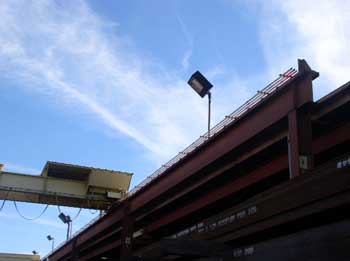
|
|
Exhibit 1. The gantry crane that was involved in the incident.
|
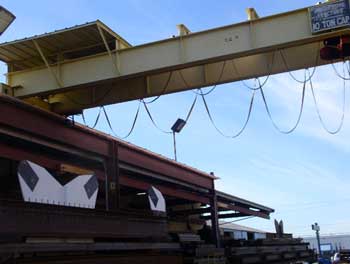
|
|
Exhibit 2. The gantry crane from a different angle.
|
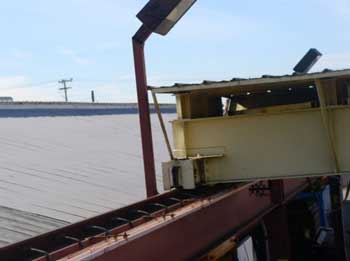
|
|
Exhibit 3. The gantry crane and the light standard against which the victim was crushed.
|
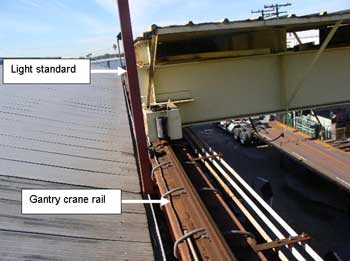
|
|
Exhibit 4: The rail the gantry crane rides on and the close proximity to the light standard.
|
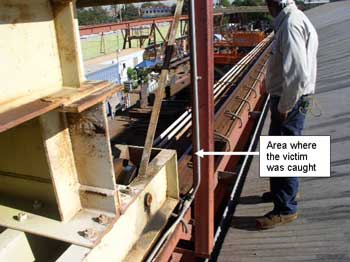
|
|
Exhibit 5: The area where the victim was caught between the light standard and the gantry crane.
|
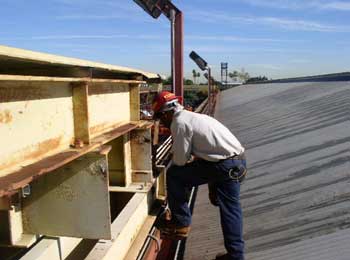
|
|
Exhibit 6: The approximate position of the victim just prior to the gantry crane making contact and pinning him against the light standard.
|
California Fatality Assessment and Control Evaluation (FACE) Project
The California Department of Health Services, in cooperation with the Public Health Institute and the National Institute for Occupational Safety and Health (NIOSH), conducts investigations of work-related fatalities. The goal of this program, known as the California Fatality Assessment and Control Evaluation (CA/FACE), is to prevent fatal work injuries in the future. CA/FACE aims to achieve this goal by studying the work environment, the worker, the task the worker was performing, the tools the worker was using, the energy exchange resulting in fatal injury, and the role of management in controlling how these factors interact. NIOSH-funded, state-based FACE programs include: Alaska, California, Iowa, Kentucky, Massachusetts, Michigan, Minnesota, Nebraska, New Jersey, New York, Oklahoma, Oregon, Washington, West Virginia, and Wisconsin.
To contact California State FACE program personnel regarding State-based FACE reports, please use information listed on the Contact Sheet on the NIOSH FACE web site. Please contact In-house FACE program personnel regarding In-house FACE reports and to gain assistance when State-FACE program personnel cannot be reached.
